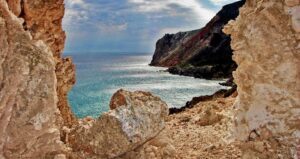
As you age — I am currently 41 — you realize that the most profound moments in your life will likely pass you by without taking note that they are happening. The first time you really, truly, fall in love, for example. The first time you experience heartbreak. The last time you feel your child kick in your belly or the feeling of carrying her while she is sleeping. The only time you experience the Platonic Ideal of the ocean, when you swim in water so clear and blue that no other swim you ever take in your brief time on earth will ever compare.
The latter happened for me in the Aegean Sea just off the cost of Milos, a Greek volcanic island just north of the Sea of Crete. It was a Saturday morning in October, 2022. I boarded a sailboat in Adamantas, the main port on the island. The town is defined by the square and rectangularly shaped, whitewashed architecture typically characteristic of the Greek islands, and is full of small cafes serving ouzo with ice and French fries.
_____________________________
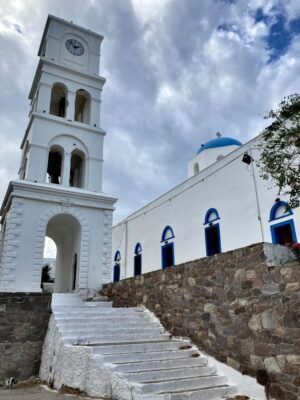
Above and below: Detailed views of the picturesque Saint Haralambos Adamantas Holy Orthodox Church in Adamantas, which can be reached easily on foot, a short walk from the many restaurants that grace the nearby shore.
_____________________________
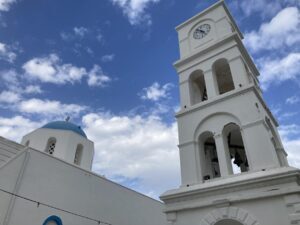
_____________________________
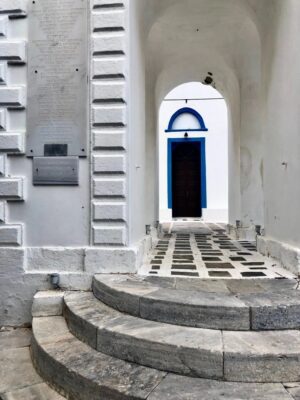
_____________________________
The sailboat, which is owned by the tourism company Thalassitra Sailing, was filled with dozens of other tourists from all over the world. I was lucky to find a spot with my traveling companion on the deck under a raised, supported tarp that provided shade from the sun, which blazed hot despite the time of year.
_____________________________
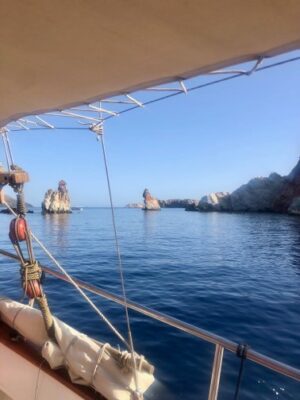
A view from beneath the overhead tarp of the boat.
_____________________________
I confess that I had low expectations for this experience. I generally don’t like being on a boat. A lifelong New Yorker, I moved with my family to Savannah, Georgia, in 2020. In our first year in Savannah, which is surrounded by saltwater marshes, my husband bought a membership to a boat club. We spent many stressful days with our two young kids on a rented boat, navigating the wind and narrow channels of the marshes of our new home in unbearable heat and humidity. On a particularly bad day, my husband misread the tides and got us stuck on a sand bank for eight hours. Our only companions beyond immediate family during that trip were a pair of Atlantic sharp nose sharks hungrily feeding in the shallow waters where we were marooned. Our only sustenance were soggy sandwiches from Publix.
As a result of our short foray into boating, I came to see boats as hot, uncomfortable and headache-inducing crafts. How could a boat ride in Milos be any better, especially given that it was a full day trip, costing 220 euros, with a significant number of couples looking to get drunk, along with an Instagram influencer who recorded every second of the trip with a GoPro?
I saw one silver lining. The water surrounding Milos is turquoise, and clear. If nothing else, I thought, the views would be beautiful.
_______________________________
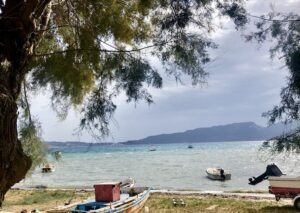
_______________________________
From the shore, the ocean looked like some version of what I have seen in the Caribbean. Clear waters in shades of blue that beg the use of a thesaurus — not just blue or turquoise, but azure, cerulean, lapis lazuli, “the color of the sea.” I saw such waters in the U.S. Virgin Islands, where I traveled on an apocalyptic trip with my insane family during college, and in Miami, which I had visited for Art Basel when I was writing art criticism. Milos has the sort of water that draws people to spend their yearly savings on a cruise. The sort of water that inspires rapturous re-awakenings during midlife crises.
Back to this boat ride later….
The Sites
The water was visible from every point on Milos, which I had spent two days exploring with my able guide, Averkios, who had been born and raised on the island. Bolstered by cigarettes and little glass bottles of Tsipouro, which he drank with water on ice every time I stopped for a meal, Averkios kept me busy to the point of exhaustion.
Bronze Age ruins and walking on the moon
Averkios showed us every cultural touchstone and hidden gem on the island, a landmass 58 square miles large. We started at Phylakopi, an ancient Bronze Age settlement set on a cliff on the north shore. This site, unknown to most people, was in its day one of the most significant Cycladic urban centers of its time.
______________________________
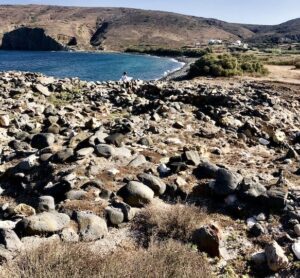
______________________________
The site today, to an undiscerning eye, looks something like a jumble of rocks. It takes considerable imagination to imagine it inhabited. Wandering through it with Averkios on narrow paths marked by lines of rope, I marveled most at the walls in the settlement that remained standing. Looking at the dry, barren landscape around Phylakopi, I wondered how far the humans, who were likely part of the Minoan civilization, ventured inland, if at all. To them, did the island seem big?
____________________________
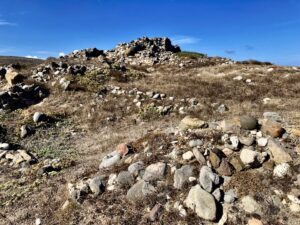
____________________________
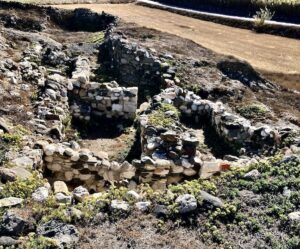
Above and below: some of the ancient walls of Phylakopi can still be easily discerned.
____________________________
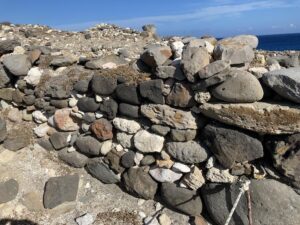
____________________________
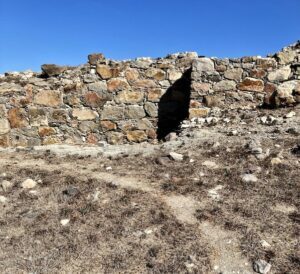
____________________________
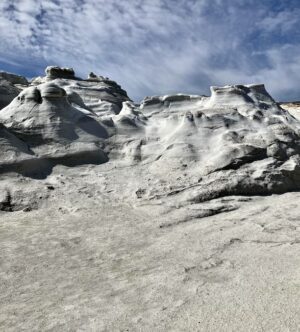
Above and below: Sarakiniko.
Just down the coast, we walked the “moonscape” that is Sarakiniko Beach, which was formed by the erosion of white volcanic rocks.
____________________________
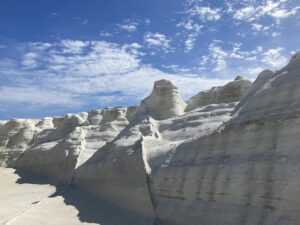
____________________________
The beach gave me a clue to why I was about to experience the best swim of my life, although I didn’t realize it at the time. There was no sand. Instead, visitors to the beach rested against hard white rocks, as if they were on a ‘moon vacation’. Swimmers lounged in a calm cove formed by erosion. At the edge of the beach, daredevils jumped from a high rock into deep waters while crowds of onlookers watched them.
____________________________
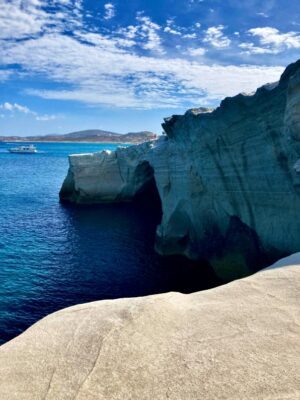
____________________________
The beach, I noted, was crowded with couples, many of them seemingly on their honeymoons.
____________________________
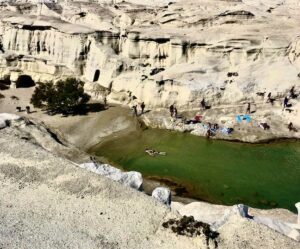
____________________________
Young, beautiful people lethargic in the heat. Many of them arrived together on rented mopeds, in perfectly appointed clothing.
____________________________
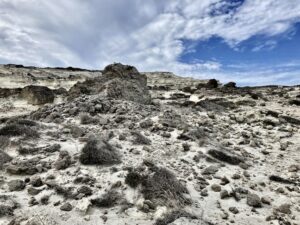
Just outside the crowded beachcomber’s area, the Sarakiniko landscape continues to evoke an otherworldly sense.
____________________________
Watching them, I missed my own husband acutely. Not as we are today, after ten years of marriage, but as we were when we first met and fell in love, before we had kids. I wished that I could bring myself and him to Sarakiniko. In our young bodies. So that we, too, could rent a moped and spend a day lounging on the ‘moon’.
Melos
A short drive away from Sarakiniko lie the ruins of the ancient city of Melos, which was first overtaken by the Greeks during the Peloponnesian war in the fourth century BC, and later settled by the Romans, who built an amphitheater here out of marble overlooking the main bay of the island.
____________________________
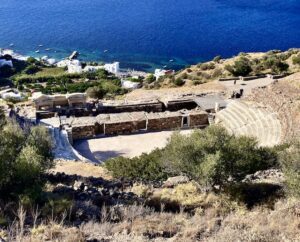
____________________________
The Roman ruins had been plundered for centuries by the locals for building materials, but it is still possible to see the incredible work it took to build a symmetrical amphitheater out of marble on a steep hillside. Averkios, who has lived with the ruins his whole life, chatted on his phone while I wandered about the remains taking photographs, moved by what, to us, was a marvel beyond comprehension.
___________________________
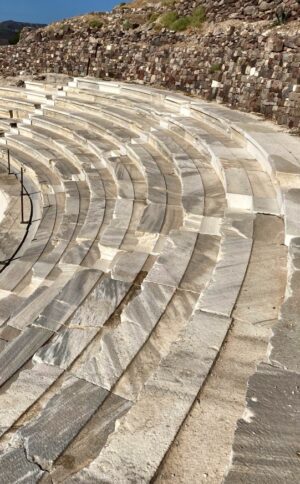
___________________________
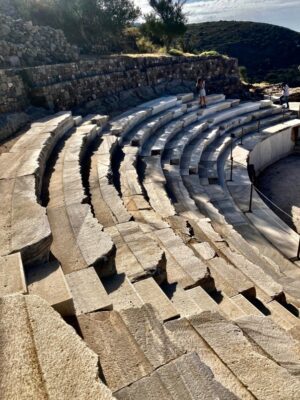
The author with Averkios on the steps of the amphitheater, shown here for scale.
___________________________
Venus
Only a short hike uphill from the amphitheater is a dry, weed-covered space that would go unnoticed by any by-passer if it was not for the fact that in this spot, over 200 years ago, one of the world’s most famous works of art was discovered by a local farmer. The farmer, it is rumored, was looking for materials for his house. Pulling aside a slab of marble, he came upon a cave in which was buried the Venus de Milo, in pieces, along with less impressive sculptures. Recognizing an opportunity, the farmer sold the Venus de Milo to a French naval officer, who was docked in the bay at the time. The naval officer took the statute back to Paris, where he gifted it to Louis XVIII. Louis XVIII, in turn, gifted it to the Louvre, where it is still exhibited to this day. (“A nice statue, but that is all,” sniffed Averkios when I asked him if he thought the statue was worth its hype.)
___________________________
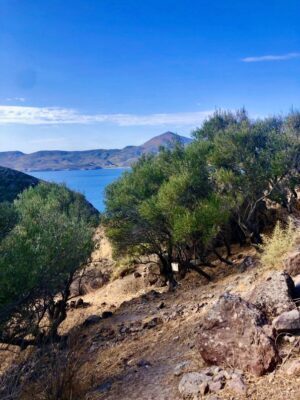
The approach to the Venus de Milo discovery site.
___________________________
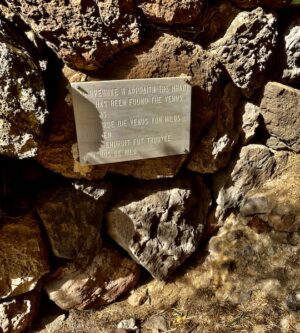
___________________________
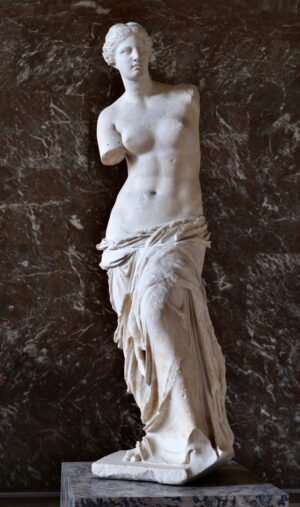
The original Venus de Milo, as exhibited in the Louvre. Shonagon, CC0 1.0 Universal, Wikimedia Commons
___________________________
Klima
The Venus de Milo discovery site was also near the catacombs where the Christians, who likely buried it (as it was a pagan icon), laid their own dead to rest in the first millennium A.D. We visited these catacombs, as well. They are considered to be among the most important and earliest Christian catacombs and places of worship in the world. Nearby, the charming, picturesque modern seaside village of Klima, marked by bright, rainbow-colored doorways leading directly to the ocean, was only steps away.
___________________________
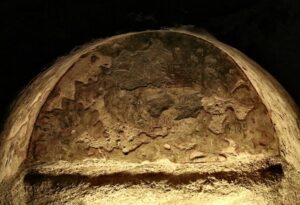
Above and below: early christian tombs in the catacombs of Milos. Zde, CC BY-SA 4.0, Wikimedia Commons
___________________________
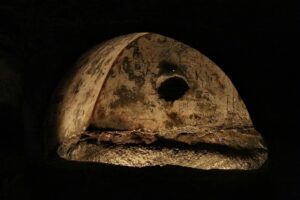
___________________________
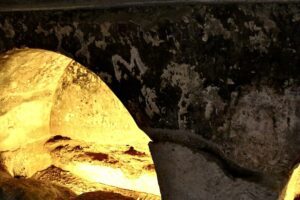
___________________________
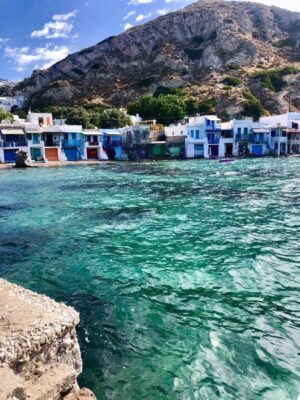
Above and below: the enchanting picturesque fishing village of Klima.
___________________________
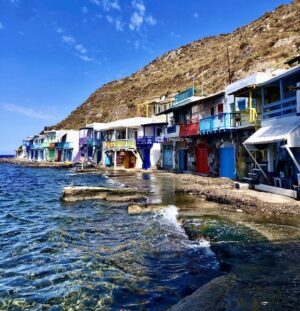
___________________________
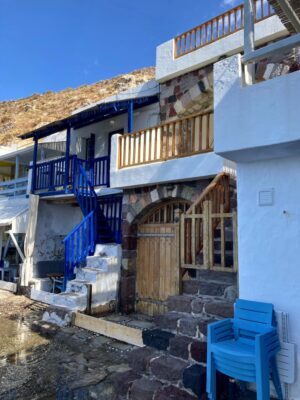
___________________________
Plaka
Averkios did not stop with us there. We also hiked the steep inclines of Plaka, the capitol town of Milos, which is full of winding streets, fuchsia bougainvillea and cute little shops. Crowned by a Venetian castle built in the 13th century and abandoned in the 19th century, Plaka is famous for its sunset views as seen from its heights. It is also a wonderful place to get a leg workout given that the climb to the Venetian castle requires ascending over 200 steps — and then descending them.
__________________________
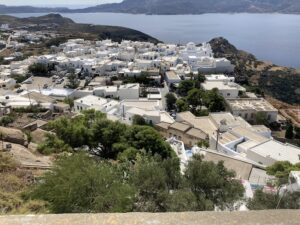
Plaka, as viewed from the Venetian ‘castle’.
______________________________
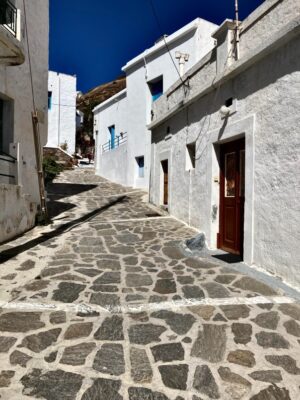
Above and below: the streets of Plaka.
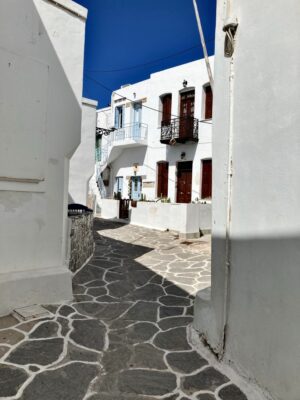
__________________________
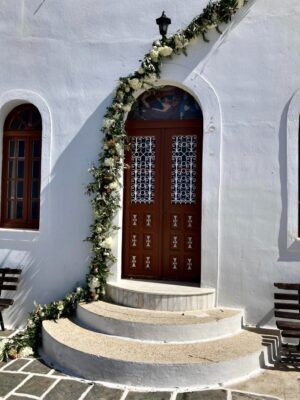
__________________________
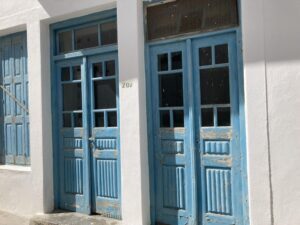
__________________________
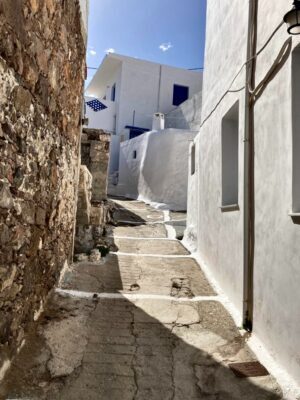
__________________________
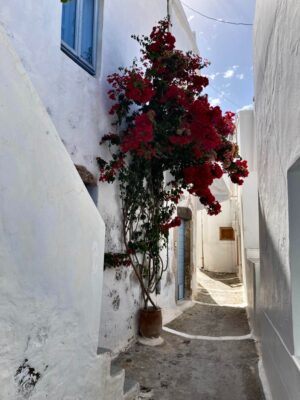
__________________________
A notable stop during our tour was the Milos War Museum, which is housed in a former World War II bunker built by locals forced into labor by the occupying Nazi party. The museum, which was spooky and damp, is personally maintained by Averkios, who fished the key to the front door out from behind a rock near the entrance. Inside, the museum is filled with memorabilia from the world wars, as well as photographs of local families, most of whom Averkios could identify by name.
Eating….and feral cats
During our journey, we only sat down to drive to a new location, or for lunch. On the first day, we ate at the Medusa restaurant, where we feasted on whole grilled anchovies and swordfish kebabs on a terrace overlooking the ocean. Nearby was Mandrakia, yet another picturesque fishing village marked by colorful stairways.
____________________________
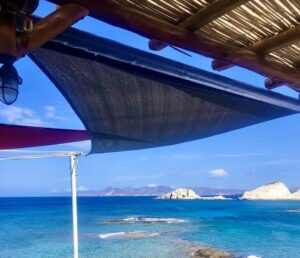
The view from the Medusa.
____________________________
On the second day, we ate at Kyra Milos, on a terrace at the base of the steps leading up to the Archaeological Museum of Milos. There, I ate so much baked feta and fresh pita that I swore I would go home 10 pounds heavier than I arrived. Averkios drank his Tsipouro and feasted on French fries. My traveling companion, harangued by feral cats, was rewarded for feeding one by a fierce bite on the hand. It’s been a long time since humans have worshipped the ancient Greek gods, and maybe those feral cats are inhabited by the spirits of those we have forgotten, hungry for respect more so than they are for table scraps.
A small museum with a big treasure
The Archaeological Museum of Milos, where a plaster copy of the Venus de Milo currently resides, is a small institution full of treasures that in other, less remote museums, would draw crowds. Along with cases full of Bronze Age jewelry, there is the Lady of Phylakopi, a terracotta statue that depicts a female figure, likely a priestess or a goddess, who lends credence to the idea that the ancient inhabitants of Milos were ruled by women.
___________________________
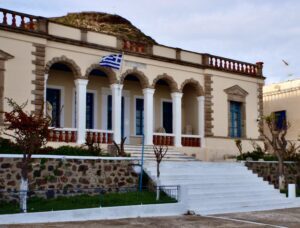
Milos Archaeological Museum. WORD TEACH, Public Domain, Wikimedia Commons
___________________________
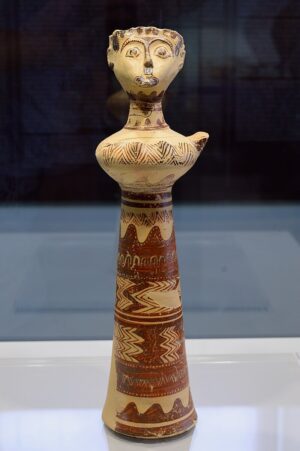
Lady of Phylakopi. Zde, CC BY-SA 4.0, Wikimedia Commons
___________________________
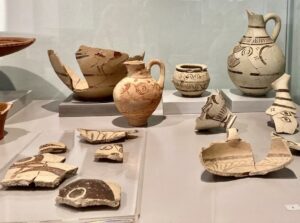
Above and below: Pottery and clay artifacts discovered at Phylakopi.
___________________________
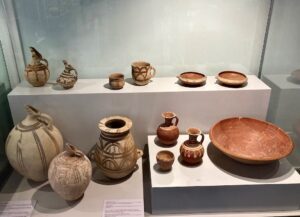
___________________________
Born of fire
The Greek islands have a complex geological history. Many of them were formed by a collision that occurred 50 million years ago when the African plate collided with the Eurasian plate, forming, among many other landmasses, the Alps. These islands consist of limestone and marble. Milos, like nearby Santorini, was formed from volcanic eruptions that first appeared in the archaeological record 1.5 million years ago and continued intermittently until roughly 3,600 years ago. This final eruption likely led to the end of Minoan society and may account for the reason why humans abandoned Phylakopi for ancient Melos, which is on the opposite shore of the island.
The volcanic eruptions led to landmasses that were mineral rich and sediment-lite, bad for farming but great for mining. Milos has been a site for mining resources since Neolithic times, when humans first discovered obsidian used for tools and barter. In the 20th century, Milos was mined — to the detriment of its local population, who worked in slavery-like conditions — for bentonite, baryte, kaolin and manganese, which are used for industrial production. The history of Milos as a mining center is meticulously preserved in the Milos Mining Museum, which was located just a few short blocks from the clean and comfortable rooms Dan and I slept in, (for the rate of just over 80 euros each a night, near the center of Adamantas).
An unexpected side effect of this mineral rich landscape, which I was to discover on our sailboat trip, was a lack of run-off from the land. There is no sand or sediment in the water. No murk, no vegetation. Instead, even far off the coast of Milos, in ocean hundreds of feet deep, the ocean floor is white volcanic rock. Sea life is not teaming there, no coral. The sunlight, when it reflects upon the white rock, creates that polyonymous blue water. The stuff of legend. The stuff that makes you believe that gods are real, and nymphs might lurk in caves below the ocean.
Return to sailing in paradise
As we crept out into the ocean on the sailboat, I felt apprehension. I have a healthy, primal fear of the ocean born from respect for its power. But also, to be clear, firsthand knowledge that sharks live in the ocean, along with other creatures that no one can see in the muddy waters of the northern Atlantic Ocean that I was most familiar with most of my life. I knew that I would be expected to swim in the ocean in Milos, but I didn’t want to. I was afraid. The volcanic rock formations, which distinguished and dominated the coast like sand castles made by giant children dripping sand from clenched fists, were intimidating. When we pulled up alongside a rock formation that looked like it had been formed from crystals and then covered in cement, I wondered if anyone would notice if I stayed on the boat.
____________________________
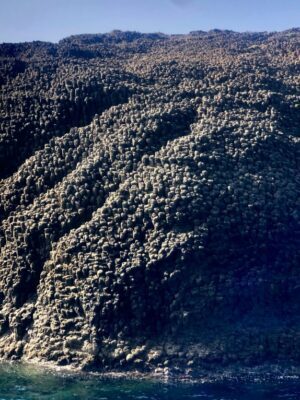
Volcanic rock formations along the coastline.
____________________________
But I forced myself to take a snorkel and dive into the water. It was October, but it was hot. Even still, the ocean had cooled as if in anticipation of the onset of for the coming winter. The cold was a shock, but it felt perfect after baking in the sun. I swam near the volcanic rock formation, staying close to the other passengers on the boat. With them, I swam into a cave. The water was creature free and clear. I threw my arms up in a shower of sunlight. My traveling companion captured a picture of my joy. I posted it on Instagram with a caption that made me think that I might be embarrassed by it later.
____________________________
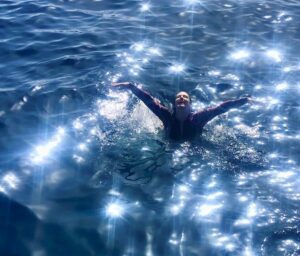
____________________________
This first swim was only a preview. The next stop was the deep waters just off Polyaegos, an island inhabited only by goats. There, the rock formations were white and burnt sienna. They looked like a piece of marble in a billionaire’s entrance hallway. The ocean beneath the boat was hundreds of feet deep. And it was totally clear.
____________________________
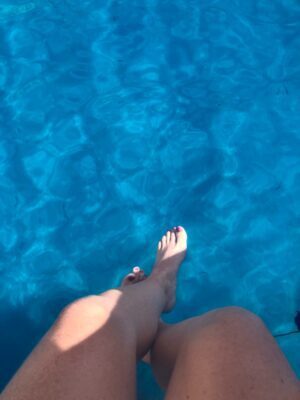
____________________________
I descended on a ladder from the boat into the water. And it was there that I experienced a perfect swim for the first — and perhaps the last time — in my life.
____________________________
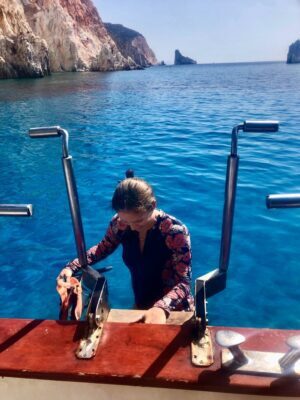
____________________________
I’m someone who, consciously or not, is always on the quest for perfection. Perfection in food, perfection in art, perfection in the things I write and the clothes I wear. Perfection in the way I interact with the world. But perfection is, as anyone with a brain can tell you, elusive, and almost always singular. In the past, when I’ve thought that I was about to experience perfection, I’ve been disappointed. In the Caribbean, the water looks perfect, but like most ocean water, it is full of seaweed, and other ocean plants. It is full of rocks and sand that interfere with the notion of “completely clear.” In the water of Polyaegos, there was no interference. Only the sheer white and orange cliffs, and beneath my body, an ocean that was nothing but ocean. The physical embodiment of perfect water. A platonic ideal.
I knew, even if I came to Milos again, I might never find that water again. So, I enjoyed it.
____________________________
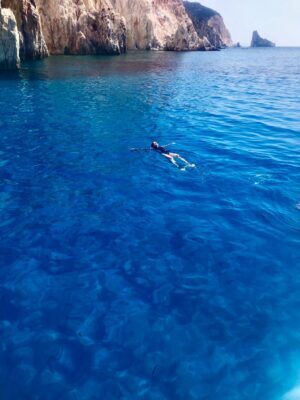
____________________________
I stayed in the water until my whole body was shaking from feeling cold. I floated on my back. I put my face in the ocean and watched the fish, which were few, swim. I followed other tourists near to the cliffs and back to the boat. There, we were treated to a lunch of moussaka, Greek salad and other delights. After swimming in the perfect cold water, I was ravenous.
____________________________
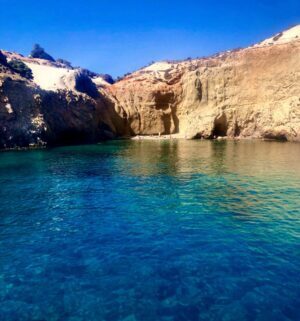
____________________________
There are thousands of Greek islands you can visit. All of them gorgeous, I’m sure, although I’ve only been to Milos. Even still, if I ever go back to Greece, I’ll go to Milos again. And not only for the clear ocean. It’s the fact that Phylakopi might have been the center of a matriarchal society. I learned this from a local archaeologist, Pavlos Kotronakis, who noted that both the female icons found buried at the site, as well as the lack of armaments, led many historians to surmise that women ruled the settlement. I could feel those women all over the island. I could feel them in the water. It was safe there. The people who lived in Phylakopi did not build battlements to keep themselves safe from intruders — or from waves. What did they do differently from us today besides settle on an island with an ocean so pure?
____________________________
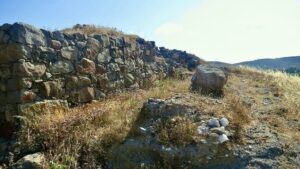
Mycenaean fortifications, south of the top of the Archeological site in Phylakopi. Late Bronze Age. View from west. Zde, Creative Commons Attribution-Share Alike 4.0 International, Wikimedia Commons
____________________________
The boat trip lasted many hours. We followed the coastline of Milos, sailing around its many hidden coves and beaches, some of them only accessible from ladders thrown off the tops of cliffs.
____________________________
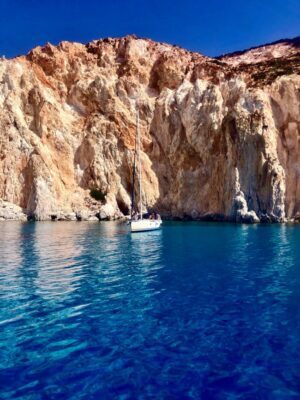
____________________________
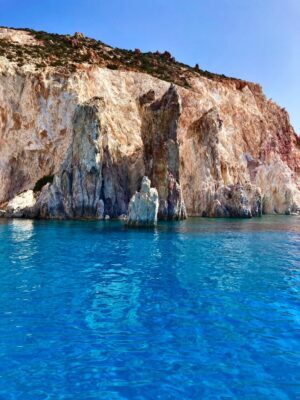
____________________________
We saw the sites of abandoned mines. We saw the circular rock formations and caves of Kleftiko, which served as a hideout and vantage point for pirates up until the 19th century.
____________________________
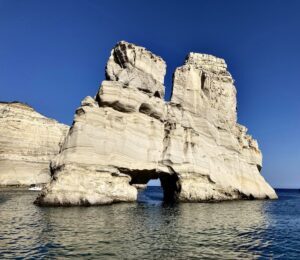
Above and below: the spectacular formations of Kleftico.
____________________________
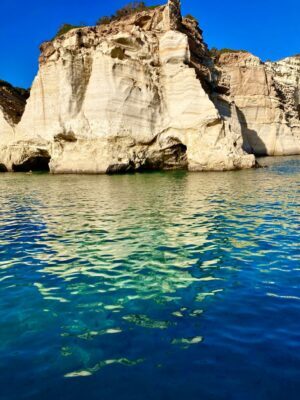
____________________________
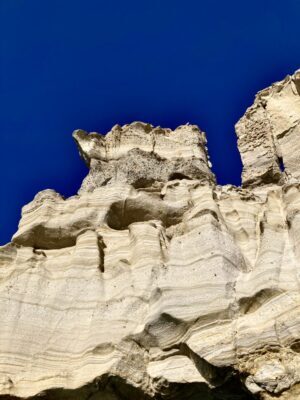
____________________________
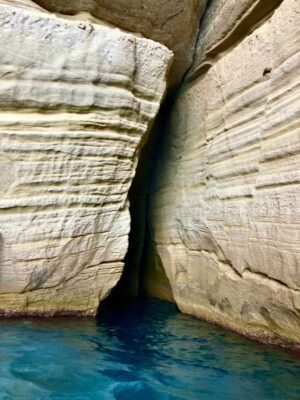
Many of us embarked from the main boat into smaller boats and, guided and piloted by the main sailboat crew, explored more closely the coves and crevices of the amazing formations. The image below was taken within a sea-cave looking out toward the opening to the sea.
____________________________
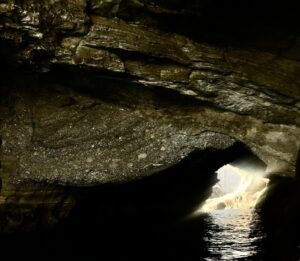
____________________________
I swam a few more times, though none of the swims were the same as the one off Polyaegos. None will be the same ever again, I believe. I recently traveled to Turks & Caicos, whose turquoise waters are world famous. But this was my first thought when I dove into the ocean there, which was alive with coral reefs and plant life….
“This is beautiful, but it’s not Milos.”
Cover Image, Top Left: Milos. olleaugust, Pixabay
____________________________
If you liked this article, you may like The Forgotten City, a more in-depth story of the archaeological site of ancient Phylakopi, published at Popular Archaeology on July 1, 2023.
____________________________
Advertisement

EXPLORE THE ANCIENT ETRUSCANS IN PERSON!
Experience a unique, up-close-and-personal hike among ancient hilltop towns in central Italy. You will walk the sensational countryside of the regions of Umbria and Tuscany, soaking in important sites attesting to the advanced Etruscan civilization, forerunners of the ancient Romans; imposing architectural and cultural remains of Medieval Italy; local food and drink; and perhaps best of all — spectacular scenic views! Join us in this collaborative event for the trip of a lifetime!


